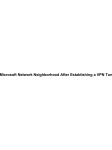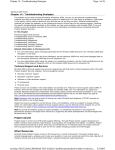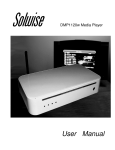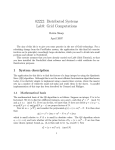Download CONFIGURING AND TROUBLESHOOTING CONNECTIVITY
Transcript
LAB 8 CONFIGURING AND TROUBLESHOOTING CONNECTIVITY This lab contains the following exercises and activities, some of which are optional: ■ Exercise 8.1: Configuring an Internet Connection ■ Exercise 8.2: Installing a Modem (Optional) ■ Exercise 8.3: Querying a Modem from Modem Properties (Optional) ■ Exercise 8.4: Common Modem Settings (Optional) ■ Exercise 8.5: Changing Workgroups ■ Exercise 8.6: Using the Repair Feature for Network Connections ■ Exercise 8.7: Obtaining an Automatic Private IP Address ■ Exercise 8.8: Joining a Domain ■ Exercise 8.9: Using Network Diagnostics in the Help and Support Center ■ Exercise 8.10: Using PING ■ Exercise 8.11: Using Tracert, Pathping, and NSlookup ■ Exercise 8.12: Restoring the System for Future Labs ■ Exercise 8.13: Submitting Your Work ■ Lab Review Questions ■ Lab Challenge 8.1: Using the Command Line to Troubleshoot a Connection Failure BEFORE YOU BEGIN ■ Start the Server virtual machine ■ Once the Server virtual machine is fully started, start the Computer01 and Computer02 virtual machines SCENARIO You are a technical support agent at Contoso, an insurance provider. Recently, many new employees have been added to the network and given limited Internet access. It is your job to troubleshoot the network and Internet connectivity. 1 2 SUPPORTING USERS AND TROUBLESHOOTING DESKTOP APPLICATIONS ON WINDOWS XP After completing this lab, you will be able to: ■ Install and configure a dial-up connection ■ Change workgroups ■ Use and understand the Repair feature for network connections ■ Use APIPA ■ Join a computer to a domain ■ Use Network Diagnostics in the Help And Support Center ■ Use command-line utilities to diagnose network problems Estimated lesson time: 100 minutes Estimated lesson time for optional exercises: 70 minutes NOTE Exercises 8-1 and 8-2 configure a connection and modem that will not be functional. They are only installed to allow practice with their user interfaces. EXERCISE 8.1: CONFIGURING AN INTERNET CONNECTION Estimated completion time: 5 minutes An executive of Contoso brings in his laptop computer and wants you to configure his computer for dial-up connectivity. 1. Log on to the Computer01 virtual machine with the Administrator account (the password is Pa$$w0rd). 2. From the Start menu, select My Network Places. 3. In the My Network Places window, in the Network Tasks section, click View Network Connections. 4. In the Network Connections window, in the Network Tasks section, click Create A New Connection. 5. In the New Connection Wizard, on the Welcome To The New Connection Wizard page, click Next. 6. On the Network Connection Type page, verify that Connect To The Internet is selected and click Next. 7. On the Getting Ready page, select Set Up My Connection Manually, and click Next. LAB 8: CONFIGURING AND TROUBLESHOOTING CONNECTIVITY 8. On the Internet Connection page, verify that Connect Using A Dial-Up Modem is selected, and click Next. 9. On the Connection Name page, in the ISP Name text box, type Contoso, and click Next. 3 10. On the Phone Number To Dial page, in the Phone Number text box, type 1-000000-0000. Click Next. 11. On the Internet Account Information page, in the User Name text box, type your name. In the Password and Confirm Password text boxes, type Pa$$w0rd. Click Next. 12. On the Completing The New Connection Wizard page, click Finish. QUESTION Why might you see a red X over the Contoso connection icon in the Network Connections window? NOTE Because this lab is long, the following exercise is optional. It can be skipped without consequence to future labs. However, if you do not complete this exercise, you should not complete Exercises 8-3 or 8-4. EXERCISE 8.2: INSTALLING A MODEM (OPTIONAL) Estimated completion time: 10 minutes Now that you have created an Internet connection for the executive in the previous exercise, you need to install a modem. 1. In Control Panel (switch to Classic view if necessary), double-click Add Hardware. 2. In the Add Hardware Wizard, on the Welcome To The Add Hardware Wizard page, click Next. 3. On the Is The Hardware Connected? page, select Yes, I Have Already Connected The Hardware, and click Next. 4. On the The Following Hardware Is Already Installed On Your Computer page, in the Installed Hardware list, scroll to the bottom and select Add A New Hardware Device, as shown below. Click Next. 4 SUPPORTING USERS AND TROUBLESHOOTING DESKTOP APPLICATIONS ON WINDOWS XP 5. On the The Wizard Can Help You Install Other Hardware page, select Install The Hardware That I Manually Select From A List (Advanced), and click Next. 6. On the From The List Below, Select The Type Of Hardware You Are Installing page, in the Common Hardware Types list box, select Modems. Click Next. 7. On the Install New Modem page, select the Don’t Detect My Modem; I Will Select It From A List check box, and click Next. 8. On the Install New Modem page, in the Manufacturer list box, ensure that (Standard Modem Types) is selected. In the Models list box, select Standard 56000 bps Modem and click Next. 9. On the Install New Modem page, in the ports window, select COM1. Click Next. 10. The Install New Modem page appears. Click Finish when it becomes active. 11. Close all open windows. 12. From the Start menu, select My Network Places. 13. In the My Network Places window, under Network Tasks, select View Network Connections. 14. Take a snapshot of the Network Connections window and paste it into a WordPad document called YourName Lab 8, where YourName is your name, and save the file in Shared Documents. QUESTION If you saw a red X on the Contoso connection previously, why has the icon changed? LAB 8: CONFIGURING AND TROUBLESHOOTING CONNECTIVITY NOTE Because this lab is long, the following exercise is optional. It can be skipped without consequence to future labs. However, if you do not complete this exercise, you should not complete Exercise 8-4. EXERCISE 8.3: QUERYING A MODEM FROM MODEM PROPERTIES (OPTIONAL) Estimated completion time: 5 minutes To see if the executive’s modem is communicating with the computer, you will query it for information in the following steps. 1. From the Start menu, right-click My Computer and select Manage. 2. In the Computer Management console, in the console tree, expand System Tools and select Device Manager. 3. In the details pane, under the COMPUTER01 node, expand Modems, as shown below. Right-click Standard 56000 bps Modem and select Properties. 4. In the Standard 56000 bps Modem Properties dialog box, in the Diagnostics tab, click Query Modem. 5. In the Error message box, click OK. Below is depicted an example of what a correctly configured modem produces when queried in this manner. Close all open windows. 5 6 SUPPORTING USERS AND TROUBLESHOOTING DESKTOP APPLICATIONS ON WINDOWS XP QUESTION Why is querying the modem from the Modem Properties dialog box a good diagnostic measure when probing connectivity problems with a modem? NOTE Because this lab is long, the following exercise is optional. It can be skipped without consequence to future labs. EXERCISE 8.4: COMMON MODEM SETTINGS (OPTIONAL) Estimated completion time: 5 minutes The modem from the previous exercise is now working, but you want to fine-tune the settings according the user’s preferences. Turning Off the Speaker and Enabling Error Correction and Flow Control The following steps will turn off the speaker, and change settings that might improve a faulty connection. LAB 8: CONFIGURING AND TROUBLESHOOTING CONNECTIVITY 1. Log on to the Computer01 virtual machine with the Administrator account (the password is Pa$$w0rd). 2. From the Start menu, select My Network Places. 3. In the My Network Places window, in the Network Tasks section, click View Network Connections. 4. In the Network Connections window, under Dial-Up, right-click Contoso and select Properties. 5. In the Contoso Properties dialog box, in the General tab, click Configure. 6. In the Modem Configuration dialog box, clear the Enable Modem Speaker check box. 7 NOTE Hardware error correction and flow control can sometimes improve the performance of a line with a lot of noise or other problems. If a user is making a connection, but that connection is unreliable, try enabling these options. 7. If necessary, select the Enable Hardware Flow Control and Enable Modem Error Control check boxes, as shown below. Click OK. Disabling Hang-up When Idle The network connection from the modem is working great, with one exception: if it is left idle for too long, it disconnects. 1. In the Contoso Properties, select the Options tab. 2. Under Redialing Options, in the Idle Time Before Hanging Up drop-down list, select Never. Click OK. 8 3. SUPPORTING USERS AND TROUBLESHOOTING DESKTOP APPLICATIONS ON WINDOWS XP Close the Network Connections window. EXERCISE 8.5: CHANGING WORKGROUPS Estimated completion time: 15 minutes A small division of Contoso uses workgroups instead of joining to the Contoso domain. The workgroup is getting too large, though, and needs to be divided into two groups. 1. From the Start menu, select My Network Places. 2. In the My Network Places window, in the Network Tasks section, click View Workgroup Computers. 3. Note the computers present in the workgroup. 4. From the Start menu, select Run. 5. In the Run dialog box, type cmd and press ENTER. 6. At the command line, type ipconfig and press ENTER. Copy your IP address here: _______________. 7. At the command line, type exit and press ENTER. 8. From the Start menu, right-click My Computer and select Properties. 9. In the System Properties dialog box, in the Computer Name tab, click Change. 10. In the Computer Name Changes dialog box, under Member Of, in the Workgroup text box, enter the following: ❑ If your IP address ends with an odd number, type ODDCOMPUTERS. ❑ If your IP address ends with an even number, type EVENCOMPUTERS. 11. Click OK. 12. In the Computer Name Changes message box welcoming you to the new workgroup, click OK. 13. In the Computer Name Changes message box instructing you to restart to activate changes, click OK. 14. In the System Properties dialog box, click OK. 15. In the System Settings Change message box, asking if you want to restart your computer, click Yes. LAB 8: CONFIGURING AND TROUBLESHOOTING CONNECTIVITY EXERCISE 8.6: USING THE REPAIR FEATURE FOR NETWORK CONNECTIONS Estimated completion time: 10 minutes When a user at Contoso loses connectivity, it is standard procedure to run a repair on the connection, which is outlined in the following steps. 1. From the Start menu, select My Network Places. 2. In the My Network Places window, in the Network Tasks section, select View Network Connections. 3. In the Network Connections window, under LAN Or High-Speed Internet, right-click Local Area Connection and select Repair. 4. In the Repair Local Area Connection message box, click Close. NOTE When a Repair command is issued, the following are executed: ❑ Dynamic Host Configuration Protocol (DHCP) lease is renewed: ipconfig /renew ❑ Address Resolution Protocol (ARP) cache is flushed: arp -d ❑ Reload of the NetBIOS name cache: nbtstat -R ❑ NetBIOS name update is sent: nbtstat -RR ❑ Domain Name System (DNS) cache is flushed: ipconfig /flushdns ❑ DNS name registration: ipconfig /registerdns ❑ For Windows XP Service Pack 1: ❑ IEEE 802.1X Authentication Restart The following steps manually re-create the actions of the Repair option. 5. Minimize the Network Connections window. 6. Open a Command Prompt window. 7. At the command prompt, type ipconfig /release and press ENTER. 8. At the command prompt, type ipconfig /renew and press ENTER. 9. At the command prompt, type arp -d and press ENTER. 10. At the command prompt, type nbtstat -R and press ENTER. 11. At the command prompt, type nbtstat -RR, and press ENTER. 12. At the command prompt, type ipconfig /flushdns and press ENTER. 9 10 SUPPORTING USERS AND TROUBLESHOOTING DESKTOP APPLICATIONS ON WINDOWS XP 13. At the command prompt, type ipconfig /registerdns and press ENTER. An example of all these commands being run is shown below. 14. At the command prompt, type exit and press ENTER. 15. From the taskbar, restore the Network Connections window. 16. Right-click Local Area Connection and select Properties. 17. In the Local Area Connection Properties dialog box, in the Authentication tab, clear the Enable IEEE 802.1x Authentication For This Network check box. Click OK. 18. Right-click Local Area Connection and select Properties. 19. In the Local Area Connection Properties dialog box, in the Authentication tab, select the Enable IEEE 802.1x Authentication For This Network check box. Click OK. NOTE Steps 17 through 19 are a re-creation of the last step that the Repair button executes: IEEE 802.1X Authentication Restart. LAB 8: CONFIGURING AND TROUBLESHOOTING CONNECTIVITY 11 EXERCISE 8.7: OBTAINING AN AUTOMATIC PRIVATE IP ADDRESS BEFORE YOU BEGIN 1. Log on to the Server virtual machine with the Administrator account (the password is Pa$$w0rd). 2. From the Start menu, select Administrative Tools, and then DHCP. 3. In the left pane of the DHCP console expand the server.contoso.com node. 4. In the left pane, select the Scope [10.1.1.0] Classroom node. 5. Right-click the Scope [10.1.1.0] Classroom node and select Deactivate. 6. In the DHCP message box, click Yes. Estimated completion time: 5 minutes A DHCP server that serves workgroup computers has gone down. Until the problem is fixed, the IT department has decided to use Automatic Private IP Addressing (APIPA) because the number of computers on the network is small. 1. Log on to the Computer01 virtual machine with the Administrator account (the password is Pa$$w0rd). 2. From the Start menu, select Run. 3. In the Run dialog box, in the Open text box, type cmd and press ENTER. 4. At the command prompt, type ipconfig /release and press ENTER. 5. At the command prompt, type ipconfig /renew and press ENTER. 6. At the command prompt, type ipconfig /all and press ENTER. QUESTION What is the new IP address? QUESTION To complete this exercise, the classroom scope on the DHCP server was deactivated. Once the DHCP server is fully activated again, what is the least action you can take to obtain a DHCP address instead of an APIPA address? 12 SUPPORTING USERS AND TROUBLESHOOTING DESKTOP APPLICATIONS ON WINDOWS XP NOTE You will now reactivate the DHCP scope for the classroom, so that you can obtain a DHCP IP address. 7. Log on to the Server virtual machine with the Administrator account (the password is Pa$$w0rd). 8. From the Start menu, select Administrative Tools, and then DHCP. 9. In the left pane of the DHCP console expand the server.contoso.com node. 10. In the left pane, select the Scope [10.1.1.0] Classroom node. 11. Right-click the Scope [10.1.1.0] Classroom node and select Activate. 12. Log on to the Computer01 virtual machine with the Administrator account (the password is P@$$w0rd). 13. Open a Command Prompt window. 14. At the command prompt, type ipconfig /release and press Enter. 15. At the command prompt, type ipconfig /renew and press Enter. EXERCISE 8.8: JOINING A DOMAIN Estimated completion time: 10 minutes Employees previously isolated from the Contoso domain in a workgroup need to have their computers added to the domain. 1. Log on to the Computer01 virtual machine with the Administrator account (the password is Pa$$w0rd). 2. From the Start menu, right-click My Computer and select Properties. 3. In the System Properties dialog box, in the Computer Name tab, click Change. 4. In the Computer Name Changes dialog box, in the Member Of section, select Domain. In the Domain text box, type contoso and press Enter. 5. In the Computer Name Changes dialog box, in the User Name text box, type AddToDomain, and in the Password text box, type Pa$$w0rd, as shown below. Click OK. LAB 8: CONFIGURING AND TROUBLESHOOTING CONNECTIVITY 6. In the Computer Name Changes message box welcoming you to the Contoso domain, click OK. 7. In the Computer Name Changes message box instructing you to restart your computer, click OK. 8. In the System Properties dialog box, click OK. 9. In the System Settings Change message box, click Yes to answer that you want to restart. 10. After the Computer01 virtual machine restarts, in the Welcome To Windows message box, press Right Alt + Delete. (Alternatively, you can select Ctrl+Alt+Delete from the Virtual PC Action menu.) 11. In the Log On To Windows dialog box, click Options. 12. In the Log On To drop-down list, select CONTOSO. 13. In the User name box, type Student. In the Password text box, type Pa$$w0rd. Click OK. 13 14 SUPPORTING USERS AND TROUBLESHOOTING DESKTOP APPLICATIONS ON WINDOWS XP 14. From the Start menu, select Run. In the Run dialog box, in the Open text box, type cmd and press Enter. 15. At the command prompt, type net config workstation and press Enter. 16. Take a snapshot of the command prompt window, an example of which is shown below, and paste it into the YourName -Lab8 WordPad document that you created earlier. 17. Close all open windows. EXERCISE 8.9: USING NETWORK DIAGNOSTICS IN THE HELP AND SUPPORT CENTER Estimated completion time: 10 minutes You are having trouble diagnosing a problem with the network. A Tier 2 technician has asked you to produce a diagnostic report on the networking components of the computer. 1. Log on to the Computer01 virtual machine in the Contoso domain with the Student account (the password is Pa$$w0rd). 2. Click the desktop in a blank area and press F1 to start the Help And Support Center. 3. In the Help And Support Center, in the Search text box, type diagnose network, and press ENTER. 4. In the Search Results pane, click Network Diagnostics. 5. On the Network Diagnostics page, click Set Scanning Options. 6. Under Options, select and clear the check boxes as shown below. LAB 8: CONFIGURING AND TROUBLESHOOTING CONNECTIVITY 7. Once the options are set, click Scan Your System. The more computers that are on the network, the longer the scan will take. QUESTION What three broad categories are the results of the scan divided into? QUESTION What is the default gateway according to the results of the diagnosis? 8. On the Network Diagnostics page, click Save To File. This will place a file on the desktop that can be used for diagnosing network problems. It contains the results of the scan. 9. In the File Saved message box, click OK. 10. Log off and log on to Computer01 with the local Administrator account (the password is Pa$$w0rd). Be sure to set the Log On To drop-down list to COMPUTER01 (this computer). 11. From the Start menu, select My Network Places. 12. In the My Network Places window, in the Network Tasks section, click View Network Connections. 13. In the Network Connections window, under LAN Or High-Speed Internet, right-click Local Area Connection and select Disable 15 16 SUPPORTING USERS AND TROUBLESHOOTING DESKTOP APPLICATIONS ON WINDOWS XP 14. Click a blank space in the Network Connections window. 15. In the See Also section, click Network Troubleshooter. 16. In the Help And Support Center, on the Networking Problems page, under Fix A Problem, click Diagnose Network Configuration And Run Automated Networking Tests. 17. On the Network Diagnostics page, click Set Scanning Options. Set the options according to step 6. Click Scan Your System. Note that many of the diagnostics are different because the network card has been disabled. Example results are shown below. 18. In the Network Connections window, right-click Local Area Connection and select Enable. 19. Close all open windows. EXERCISE 8.10: USING PING Estimated completion time: 10 minutes To solve common networking issues, you use several command-line tools. A user has had a network diagnostics and a repair run on her computer but still has connectivity problems. It is your task to use command-line tools to help diagnose the problem. The following steps use the Ping command to check connectivity. LAB 8: CONFIGURING AND TROUBLESHOOTING CONNECTIVITY 1. Log on to the Computer01 virtual machine with the local Administrator account (the password is Pa$$w0rd). 2. From the Start menu, select Run. In the Run dialog box, in the Open text box, type cmd and press ENTER. 3. At the command prompt, type ping 127.0.0.1 and press ENTER. A sample result is shown below. 4. Minimize the command prompt window. 5. From the Start menu, select My Network Places. 6. In the My Network Places window, in the Network Tasks section, click View Network Connections. 7. In the Network Connections window, right-click Local Area Connection and select Properties. 8. In the Local Area Connection Properties dialog box, in the General tab, in the This Connection Uses The Following Items section, clear the Internet Protocol (TCP/IP) check box and click OK. 9. In the Network Connections message box, click Yes. 10. Minimize the Network Connections window, and restore the command prompt window. 11. At the command prompt, type ping 127.0.0.1 and press ENTER. 12. At the command prompt, type ping -n 20 server and Press ENTER. 13. Minimize the command prompt window and restore the Network Connections window. 14. In the Network Connections window, under LAN Or High-Speed Internet, right-click Local Area Connection and select Properties. 17 18 SUPPORTING USERS AND TROUBLESHOOTING DESKTOP APPLICATIONS ON WINDOWS XP 15. In the Local Area Connection Properties dialog box, in the General tab, in the This Connection Uses The Following Items section, select the Internet Protocol (TCP/IP) check box, as shown below, and click OK. 16. Close the Network Connections window and restore the command prompt window. 17. Press the up arrow key to restore the previous command and press ENTER. EXERCISE 8.11: USING TRACERT, PATHPING, AND NSLOOKUP Estimated completion time: 10 minutes After investigating connectivity in the previous exercise with Ping, you need to use other command-line tools to try to figure out the problem. Using Pathping The following steps use the Pathping command to diagnose connectivity. 1. From the Start menu, select Run. In the Run dialog box, in the Open text box, type cmd and press ENTER. 2. In the command prompt window, type pathping www.microsoft.com and press ENTER. Sample results from this command are shown below. LAB 8: CONFIGURING AND TROUBLESHOOTING CONNECTIVITY 3. Take a few moments to note what statistics Pathping gathers. Using Tracert The following steps use the Tracert command, which is similar to Pathping. 1. At the command prompt, type tracert www.microsoft.com and press ENTER. 2. Compare the information relayed by Tracert with that of Pathping. Using NSlookup The following steps purge your DNS cache and query available DNS servers. 1. At the command prompt, type ipconfig /flushdns and press ENTER. 2. At the command prompt, type nslookup www.microsoft.com and press ENTER. 19 20 SUPPORTING USERS AND TROUBLESHOOTING DESKTOP APPLICATIONS ON WINDOWS XP QUESTION What information does the NSlookup command convey in this instance? EXERCISE 8.12: RESTORING THE SYSTEM FOR FUTURE LABS Estimated completion time: 5 minutes This exercise must be finished to make Lab 8 compatible with subsequent labs. It will remove the modem that you installed so that it won’t interfere with exercises on network connections. 1. Log on with the local Administrator account (the password is Pa$$w0rd). 2. From the Start menu, select My Network Places. 3. In the My Network Places window, in the Network Tasks section, select View Network Connections. 4. In the Network Connections window, under Dial-Up, right-click Contoso and select Delete. 5. In the Confirm Connection Deletion message box, click Yes. Close the Network Connections window. 6. From the Start menu, right-click My Computer and select Properties. 7. In the System Properties dialog box, in the Hardware tab, in the Device Manager section, click Device Manager. 8. In Device Manager, expand the Modems node. Right-click Standard 56000 bps Modem and select Uninstall. Click OK to confirm that you want to uninstall the modem. 9. Close Device Manager and close the System Properties dialog box. EXERCISE 8.13: SUBMITTING YOUR WORK Estimated completion time: 5 minutes This exercise allows you to submit the work you completed in this lab to your instructor. 1. Log on to the Computer01 virtual machine with the Administrator account. 2. Drag the YourName Lab 8 WordPad document from the virtual machine window to the host computer. LAB 8: CONFIGURING AND TROUBLESHOOTING CONNECTIVITY 21 3.Submit the document to your instructor. LAB REVIEW QUESTIONS Estimated completion time: 15 minutes 1. Where can you find out what COM port a modem is configured to use? 2. How do you change workgroups? 3. Can a computer in a domain access the shared resources of another computer on the network that is not a member of the domain? 4. List the tasks that a network connection repair involves. 5. What command-line utility reports on data loss and the route to a particular IP address? 6. What will the -n switch do when used with the Ping command? 7. What Microsoft utility is commonly used to synchronize mobile devices with desktop computers? LAB CHALLENGE 8.1: USING THE COMMAND LINE TO TROUBLESHOOT A CONNECTION FAILURE Estimated completion time: 10 minutes You are a technical support agent at Contoso.com. A user complains that she cannot access a site on the Internet. In investigating the problem, you ask her several questions: ■ Are you able to access any other site on the Internet? Yes. ■ Have you ever accessed this site before? Yes, but not on this computer. ■ Was the computer on the same network, or on a different network? It was at home. ■ Have you made any changes recently to Microsoft Internet Explorer or your computer? No. ■ What is the site? www.dell.com Try to access www.dell.com from your computer (you will be unable). Using the tools presented in this lab, rule out your network card and DNS as the culprit. Find out at which IP address the failure is occurring. 22 SUPPORTING USERS AND TROUBLESHOOTING DESKTOP APPLICATIONS ON WINDOWS XP COMPLETING THE LAB 1. If there are files in the virtual machine that you want to save before closing, drag them from the virtual machine window to the host computer. NOTE Any files that were added to a virtual machine during a lab will not be saved when the virtual machine is closed. 2. Shut down each virtual machine by selecting Action and then Close.


































